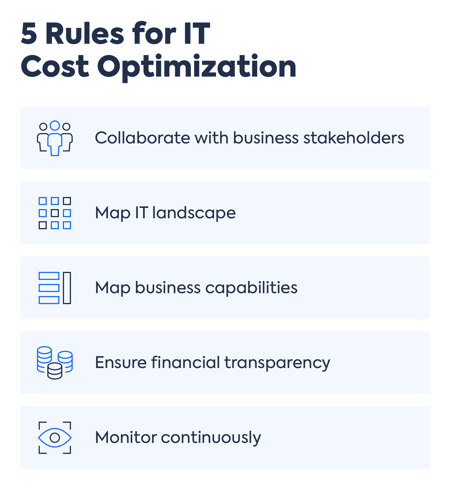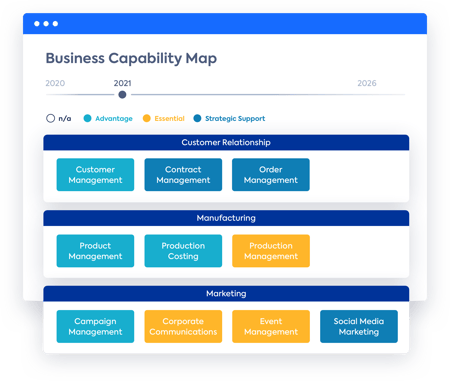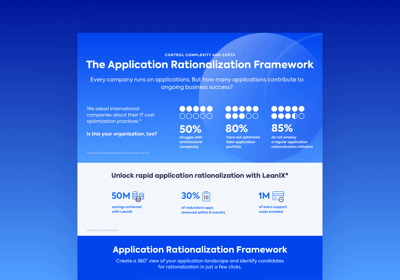IT cost optimization framework
The following 5 steps create the foundation for your IT cost optimization effort. The framework will evaluate how IT costs impact IT services and their effect on business costs and revenue.
Continuously monitor these costs to eliminate wasteful spending and maximize the value of all IT resources.

Collaborate with business stakeholders
The first step of successful IT cost optimization is to collaborate with the appropriate stakeholders. Establishing clear and structured communication with CFOs and business owners will make sure the desired outcome can be realized, as well as the required time frame and best approach.
Such relationships enable faster, better, and more structured optimization efforts going forward.
Items that need to be discussed with stakeholders include:
- Determining the desired result: What does the organization wish to achieve through its IT cost optimization project?
- Following this, stakeholders and project managers will want to determine the time frame: How long will it take to establish processes to continually monitor IT expenditure?
- Lastly, teams will need to determine the best approach and cost optimization processes: How will the organization approach the issue? What steps must be taken to ensure the project’s success?
Map IT landscape
IT cost optimization will evaluate expenditure throughout the entire IT landscape – which means you need to take stock of IT resources. IT visibility is a key part of cost optimization.
A thorough, accurate inventory of your IT landscape and visually mapping it are essential to any potential optimization.
The LeanIX Enterprise Architecture (EAM) and SaaS Management (SMP) visualize your IT architecture. With detailed insights, they allow informed decisions about where to maximize value.

Both help organizations discover which On-Prem and SaaS applications exist in their IT landscape and what business units applications are part of.
They also identify which applications can be rationalized based on their lifecycle stage, usage, business value, or risk.
These tools can also map future state architecture, which allows stakeholders to see inventory and what data flows will look like in the future, and which areas need improvement.
Map business capabilities
Once IT transparency has been established, IT assets need to be mapped to business capabilities and processes. Doing this helps identify any redundancies or gaps and reveals business value based on the business function.
Business capability map templates can help you uncover what a business does and what needs to happen to meet current and future challenges.

Business capabilities optimization is a positive outcome of IT cost optimization efforts because so much of the day-to-day operations depend on efficient use of the IT infrastructure.
Ensure financial transparency
IT cost optimization is a financial strategy, and stakeholders need to understand how IT spending affects business value. Financial transparency in IT is an important part of communicating this and serves as the foundation of your cost optimization strategy. If not, poor decisions will be made and the entire reason for IT cost optimization can be undermined and ineffective.
IT financial transparency can be achieved when all stakeholders have a single source of truth of their IT landscape. Business capabilities maps show applications, data flows, and business value for each business unit. And at the same time, it reveals optimization opportunities and required costs.
IT optimization is an ongoing discipline – not a one-time effort. Once a strategy is established, IT visibility and optimization allow for continuous analysis of IT project investments and their benefits. This creates a lean and financially efficient process from the get-go.
Monitor continuously
As previously mentioned, IT cost optimization is a continuous process of evaluating and reevaluating resources, processes, and assets. Through this IT strategy, business processes and relationships are established between the right stakeholders and IT can become a business enabler.
Collaborative tools such as the LeanIX EAM and SMP allow organizations to become more transparent and agile. Ongoing IT visibility is crucial because it uncovers all the wasted spend and inefficiencies that can easily go unnoticed in a complex IT and business landscape.
An example of this waste spend is shadow IT – unmanaged and undocumented applications or cloud SaaS/IaaS services installed without the explicit permission or knowledge of the company. Non-IT team members represent 85% of all cloud app purchases which are most often not optimized for efficiency or value.
These can be installed at any time, which is why continuous IT monitoring is important for discovering shadow IT.
All technology comes with an expiration date and needs to be updated. By decommissioning old tech, upgrading current systems, and staying on top of expired contracts, organizations can make sure money isn’t wasted.
Costs saved through this ongoing process of reevaluation can be invested in innovation and business growth.




/EN/White-Paper/EN-IDC-Inforbrief-Application-Rationalization-Portfolio-Management-Thumbnail_v2.png?width=260&height=171&name=EN-IDC-Inforbrief-Application-Rationalization-Portfolio-Management-Thumbnail_v2.png)

/EN/Reports/Thumbnail-Gartner%20720x500.png?width=260&height=171&name=Thumbnail-Gartner%20720x500.png)



/EN/Reports/LeanIX_Report_IT_Cost_Optimization_Survey_2023_EN_Thumbnail.png?width=260&height=171&name=LeanIX_Report_IT_Cost_Optimization_Survey_2023_EN_Thumbnail.png)



